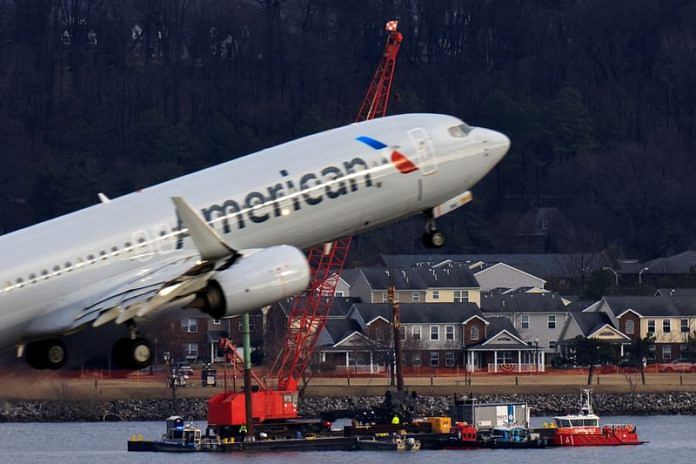By David Shepardson
WASHINGTON (Reuters) -The head of the National Transportation Safety Board sharply criticized U.S. officials for failing to act before the January 29 collision of a U.S. Army helicopter with an American Airlines regional jet in Washington that killed 67 people.
NTSB Chair Jennifer Homendy said on Wednesday that the Federal Aviation Administration did not act on warnings from air traffic control staff who proposed flight path changes to avoid such dangers and noted there had been high staff turnover at the airport’s control tower.
“Every sign was there that there was a safety risk, and the tower was telling you,” Homendy said on the first day of an investigative hearing. “You transferred people out instead of taking ownership over the fact that everybody in FAA in the tower was saying there was a problem…. Fix it. Do better.”
The crash over the Potomac River near the Ronald Reagan Washington National Airport was the deadliest U.S. air disaster in more than 20 years.
The NTSB disclosed that in 2022 members of an FAA air traffic working group had urged moving helicopter traffic away from Reagan airport and to establish airborne “hot spots” but it was rejected because the issue was “too political.”
Senator Maria Cantwell, a Democrat, cited the recommendation in sharply criticizing the FAA’s inaction.
“What caused the FAA’s oversight to be so flawed that they couldn’t fix this problem before this tragedy occurred?” Cantwell said.
Homendy noted the Reagan air traffic control tower had three managers in the last two years and around 10 since 2014.
The FAA did not respond immediately to a request for comment.
FAULTY ALTITUDE DATA
The NTSB hearing also focused on faulty altitude data in U.S. Army helicopters like the one that collided with the American Airlines jet.
The NTSB investigative hearing is looking at the Black Hawk aircraft’s air data systems and altimeters, including the potential it received faulty altitude data.
“There is a possibility that what the crew saw was very different than what the true altitude was,” NTSB Chair Jennifer Homendy said.
Testing after the crash showed that Army Black Hawk helicopters in flight showed discrepancies of 80 to 130 ft (24 to 40 m) versus the actual altitude.
Army officials said discrepancies of up to 100 ft were not a cause for concern in the Black Hawk, manufactured by Lockheed Martin’s Sikorsky division.
NTSB board member Todd Inman questioned why the Army was not doing more testing and taking other steps to alert pilots about potential discrepancies. “Could you hurry it up?” Inman said.
Homendy said that discrepancy was significant, especially given the margin of error was 75 ft at the edge of the helicopter route near Reagan airport. She also questioned if broader testing was needed and whether the issue could impact civilian Sikorsky helicopters.
The NTSB played audio excerpts of communications between air traffic control towers during the minutes before the crash, including a request by controllers to the American Airlines regional jet to shift to a different runway.
Previously, the NTSB said the helicopter’s altitude was higher than it should have been for the area at the time of the crash.
The maximum altitude for the route the helicopter was taking was 200 ft, but the collision occurred at an altitude of around 300 ft.
The Black Hawk, which was on a nighttime training flight, had a crew of experienced pilots wearing night vision goggles.
The FAA restricted helicopter flights in March after the NTSB said the presence of those aircraft posed an “intolerable risk” to civilian aircraft.
In May, the FAA barred the Army from helicopter flights around the Pentagon after a May 1 close call that forced two civilian planes to abort landings.
The FAA this week said the helicopter flights remained on hold even after the agency disclosed it had signed a new agreement with the Army on July 1.
(Reporting by David Shepardson; Editing by Chizu Nomiyama, David Gregorio and Jamie Freed)
Disclaimer: This report is auto generated from the Reuters news service. ThePrint holds no responsibility for its content.




